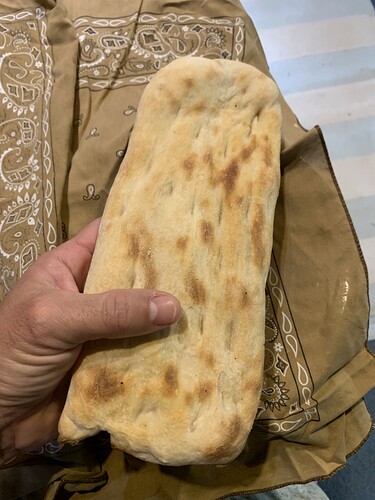I really think sourdough-leavened flatbreads deserve a more prominent place in the repertoire of beginner sourdough bakers, as well as anyone who really likes freshly baked bread. It’s hard to imagine something simpler and more convenient to make, and flatbreads avoid a lot of the issues that vex beginner artisan bread bakers like proper loaf shaping, proper proofing time, scoring, getting good oven spring. (They’re also energy efficient/eco-friendly because flatter bread cooks so much more quickly.) They can even be baked on a stovetop if you don’t have an oven. A toaster oven works great for small batches and heats up fast.
There are solid reasons why flatbreads are the daily bread of choice for much of the world, especially where fuel is scarce or people don’t always have the luxury of being able to fool around with their dough for hours.
I recently went on a trip, and I took a bit of my starter with me on two flights across ~5000 miles and 6 time zones (in the form of a dry ball of dough smaller than your thumb–not a liquid) and while we were running around doing things almost all day every day I still made bread a few times. How? Flatbreads! Made from refrigerated no-knead dough. No proofing. Very flexible wide range for the bulk fermentation time. Bake in ten minutes or less. Eat almost immediately–no waiting 1 hour + for it to cool.
About the only downside I find is that they go stale very fast. But because they’re so quick to make, after all you can easily make more fresh whenever you want!
I use a variation of the overnight no-knead “master dough” recipe I use for almost everything–on my trip I didn’t use any measuring tools at all because I’m very familiar with this dough, but below are typical percentages:
100% A P flour (can sub in some/all whole grain too!)
65% water (if you have a scale, otherwise just add water slowly and go by texture)
2% salt (or to taste)
1-4% starter, cold from the fridge (depending on the room temperature and the desired rising time, and doesn’t have to be very precise, especially for flatbreads)
Mix everything, cover, let ferment overnight, with one stretch/fold sometime during the rise (or not, really–but I think it gives a nicer texture). Refrigerate in a plastic bag until needed, use within 5-7 days (or so).
It takes perhaps 5-10 minutes of hands-on time at most, that you can fit in whenever it’s convenient. And with the dough in the fridge you can have fresh bread ready to eat anytime within minutes–especially if you have a toaster oven or gas stove and make your bread extra thin).
To make “Afghani style” naan bread, for example–as shown in photo–heat a baking tray in the oven at 450-475 fahrenheit, tear off a chunk of dough, shape into a flattened circle or oval about 1 cm thick, let rest while the oven is heating. Then dimple all over with your fingertips, and grab each end, stretching the dough to the length of your baking tray or to desired length, and place directly onto the hot tray. Bake for 10 minutes or until browned spots begin to form on the top and bottom.
Eat as soon as it’s cool enough to handle. Wrapping in a cloth will keep it warm longer and/or keep it softer. Eat any way you like: plain, buttered, with jam, cream cheese, dipped in soups or sauces, used for sandwiches, with cheeses, dipped in olive oil, whatever.
